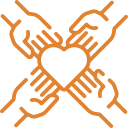Yesterday, David Hutchens and HRDQ-U hosted a free webinar entitled, Go Communicate! Exploring and Improving How Your Teams Interact. Hutchens is a bestselling author and consultant who specializes in organizational storytelling, leading, creating and innovating, organizational learning, systems, and more. He has created award-winning communications and learning solutions for companies such as IBM, The Coca-Cola Company, Wal-Mart, GE, and Nike, just to name a few.
Over 500 people registered to listen to the webinar live. If you want to watch and learn, you may do so here.
“This was one of the best webinars I’ve attended. I learned some new stuff, the visuals were way better than average – they were clear, had graphics and not too much text.”
“Exceptional training on innovation and creativity! I can use these tools immediately to increase collaboration, creativity, and productivity. Thanks so very much!”
All day, every day, teams rely on communication to get work done. But teams are made up of people—and people are human. That means teams will struggle with communication at some point in time. And that’s why it’s important for them to foster greater awareness of their own communication preferences and to exercise their capabilities for advocacy and inquiry. This way, communication becomes more than a process for transferring information; it becomes an important source of learning, transformation, and innovation.
The session began with a question. When we don’t communicate well in our teams, what is the real problem?
The options are:
- Style differences
- Low frequency
- Inappropriate content
- Lack of skill
The responses came in fast and steady! While many people had more than one problem, the majority agreed that the different styles were often to blame. So what now?
It is important to know that dialog is a discipline. There are skills involved and often times teams must practice to get their dialog to make sure their message is heard the way it is intended.
Two important aspects of dialog are Advocacy and Inquiry.
Advocate: To put ideas forward with the intent of revealing your mental models and helping others understand your thinking.
Inquire: To ask questions with the desire to understand the other person’s reasoning.
Another vital part of successful team communication is understanding Directing and Informing.
Directing: task/time focus, gives structure, direct, tell, ask, direct, urge
Informing: process/motivation focus, evoke, draw forth, inspire, seek input, inform, explain, describe, inquire
There is so much room for misunderstanding and misinterpretation that it is vital to understand how to communicate more now than ever. With more and more teams working remotely, communication is truly key.
GO Team Reproducible Library is a complete team-training resource that supports all kinds of teams, including brand new teams as well as teams that have been together for a while. It’s a “just in time training resource”, which means that you select the module that is most urgent to the team, right now- kind of like delivering an antibiotic directly at the point of need. There is a discount on this program for all attendees of the webinar!
For much more information on how to communicate with your teams and to learn the advantages and disadvantages of different types of language, click here.
Sign up today to make sure you don’t miss the next free webinar!













